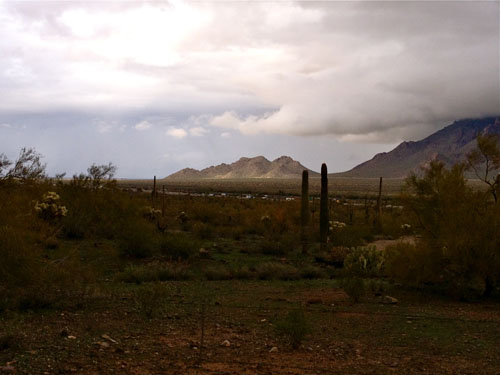
I-10, the descendant of territorial trails and country-crossing railroads, speeds through the southern half of Arizona. Its lane lines, faded by decades of sunshine, stretch from California to New Mexico and through Arizona’s largest cities, Phoenix and Tucson. Just beyond the off ramps, oddities forgotten by most entice the treasure-hunter, history buff and strange family on vacation.
“We’ve made this drive a million times,” said Joe Gingo, 27, at a Dairy Queen in Picacho. “I think it’s a nice drive.”
His girlfriend, Cassie Abbot, 25, cut him off. “Really? It’s boring, it’s just straight,” she said, expressing the assumption of many road-trippers.
About 400 miles of I-10 shoot through the state, passing city, town, and the Wild West that was. The highway was completed in 1990 when the Papago Freeway in Phoenix opened and completed a three-decade project, according to a 2011 report by the Arizona Department of Transportation (AZDOT) on the state’s transportation history.
Since that time, smaller towns and cities have starved and thrived based on the ebb and flow of I-10 traffic.
“There are cities located smack dab next to the interstate, and if the interstate wasn’t there, they might not have grown like the have,” said Dustin Krugel, the public information officer for the AZDOT. “We build the highways, but you can’t control what’s built around that.”
The road trip itself holds a certain idyll for many Americans, and the Arizona stretch of I-10, with its prickly cacti and mountain vistas, satisfies that romance with the open road.
“I think the road evokes possibility—kind of like airports can,” said Laraine Herring, the creative writing director for Yavapai College in Prescott who drove the Phoenix-Tucson stretch of I-10 nearly 200 times during her college years. “We haven’t written the next act yet, and while we’re driving between here and there, we can still make adjustments. There are an infinite number of potential lives we can lead on the open road.”
From Quartzsite to the Arizona-New Mexico border, charm and kookiness sit beyond exit ramps, inviting the road-tripper to take a detour into interstate culture.
{source}![]() <iframe width=”425″ height=”350″ frameborder=”0″ scrolling=”no” marginheight=”0″ marginwidth=”0″ src=”https://maps.google.com/maps/ms?msa=0&msid=200906926752005410400.0004d4a23bb9714f35565&ie=UTF8&t=h&ll=34.089061,-111.884766&spn=6.367184,9.338379&z=6&output=embed”></iframe><br /><small>View <a href=”https://maps.google.com/maps/ms?msa=0&msid=200906926752005410400.0004d4a23bb9714f35565&ie=UTF8&t=h&ll=34.089061,-111.884766&spn=6.367184,9.338379&z=6&source=embed” style=”color:#0000FF;text-align:left”>Weirdest Interstate Pit Stops</a> in a larger map</small>
<iframe width=”425″ height=”350″ frameborder=”0″ scrolling=”no” marginheight=”0″ marginwidth=”0″ src=”https://maps.google.com/maps/ms?msa=0&msid=200906926752005410400.0004d4a23bb9714f35565&ie=UTF8&t=h&ll=34.089061,-111.884766&spn=6.367184,9.338379&z=6&output=embed”></iframe><br /><small>View <a href=”https://maps.google.com/maps/ms?msa=0&msid=200906926752005410400.0004d4a23bb9714f35565&ie=UTF8&t=h&ll=34.089061,-111.884766&spn=6.367184,9.338379&z=6&source=embed” style=”color:#0000FF;text-align:left”>Weirdest Interstate Pit Stops</a> in a larger map</small>
{/source}
The Tomb of Hi Jolly
Your first stop in Quartzsite, Ariz. is a reminder of days bygone when 74 camels caravanned across the Southwestern desert as part of the U.S. Army’s experimental Camel Corps, started in 1856.
The monument in the Hi Jolly Cemetery marks the tomb of Hadji Ali, or Hi Jolly as he was called in the U.S. Built in 1934 by the AZDOT, the marker commemorates this camel herder who worked with the Army and eventually settled in Quartzsite after the 10-year experiment ended.
Soldiers, camels and their handlers traveled across the Southwest to assist westward expansion. Today, the town of Quartzsite celebrates their part of that history in January with Hi Jolly Daze.
Sacaton Rest Stop
South of the Phoenix sprawl at eastbound Exit 181 this rest stop has no bells and whistles, no sparkle, no pizzazz. Just a 
Prior to 1854 and the completion of the Gadsden Purchase, you would have been driving into Mexico. The Gila River designated the U.S.-Mexico border before James Gadsden, the U.S. ambassador to Mexico negotiated with Mexican President Antonio de Santa Anna, according to the U.S. Department of State’s Office of the Historian. Twenty-four percent of Arizona’s geographical area comes from the Gadsden Purchase, and a plaque at the Sacaton Rest Stop marks this historic event, Krugel said.
Family Fun World
Your next dose of intrigue comes in the form of pastel birdcages on tall poles perched alongside I-10 near Eloy. These former Magic Mountain gondolas are a faded birdsong for 157 acres of an amusement park that never existed. Internet chatter remembers other odds and ends like a metal dinosaur and racecar and a billboard promising Family Fun World, “Coming Soon.” Most of it was auctioned off in 2001.
Richard Songer, the owner, dreamed of building a drive-through zoo and amusement park on the property, according to a recent story by the Arizona Republic. When he purchased the property in 1995 for $157,000, he hoped to flood the dusty desert with concerts, animals, and a carnival atmosphere.
Rooster Cogburn Ostrich Ranch
With the camels gone and the zoo imaginary, the Rooster Cogburn Ostrich Ranch may seem a tease, but when D.C. Cogburn, who now goes by “Rooster,” and his family moved from Oklahoma to Arizona in 1993, they did so with a flock of South African Black Ostriches. Approximately 2,000 live on the 600-acre ranch, along with three generations of Cogburns.

The up-close-and-personal encounter with the ranch’s ostriches, the monster truck rides and other animal interactions keep people coming back.
“It’s a place to come and forget your worries for a while,” Cogburn said. “For some, it’s the thrill of being scared. Some just love the animals. What we’re about is truly a labor of love.”
Pinal Air Park
From the road, the Pinal Air Park looks like an airplane graveyard, with white rudders and wings sprouting from the desert landscape. You can’t get into this commercial airport without prior arrangement, but it is not a boneyard. Instead, this air park has been storing and servicing aircraft since its use during World War II. Owned by Pinal County and leased to a private company, a shroud of mystery cloaks the property.
“People who work here will wink at you and say things like ‘Oh yeah, Air America was out of here, and (the CIA) did a lot of stuff during the Vietnam War and down in Nicaragua,’” said Jim Petty the director of Pinal County’s airport economic development department. “There is so much legend and mystique, but not a lot of it can be confirmed.”
Nearby training facilities for the Arizona Army National Guard and the property’s on-again-off-again relationship with the military keeps the legends alive.
“You hear stuff about how people landed on the base accidentally and were met with guns and told to get off,” Petty said. “Even though none of that stuff happens now, it’s perpetuated because people love a good story.”
The Thing?
By the time you reach The Thing? in Dragoon, Ariz., you’re at least curious about whatever it is on the other side of Exit 322. Billboards dot hundreds of miles of I-10 leading up to The Thing, asking questions. What is it? they taunt.
For one dollar, you gain admission into a museum with an eclectic collection that “ranges from carving art to antiques to matchlock guns to everything in between,” said Mike Ward, a shift supervisor at the The Thing?, owned by Bowlins Travel Center. The Thing, a mummy-like figure, is the finale, enclosed in a cinderblock and glass case, according to “Weird Arizona: Your Travel Guide to Arizona’s Local Legends and Best Kept Secrets.”
“Our most common comment is, ‘That’s the best dollar I ever spent,’” Ward said.
The Thing came to Arizona in 1965 with Thomas Binkley Prince and his wife, and Ward said the exact origin of The Thing is unknown.
The billboards work. Anywhere between 8,000 to 10,000 visitors stop in to see The Thing each year, Ward said. A gas station, Dairy Queen and the thrill of mystery draw visitors away from the rat-race pace of I-10.
“It’s a great place to get off the road,” Ward said. “And with the Dairy Queen, you have great roadside service, and there are lots of things to see outside the store and in the museum.”
The “thing” is, to see any of this, you have to take an exit or two.



